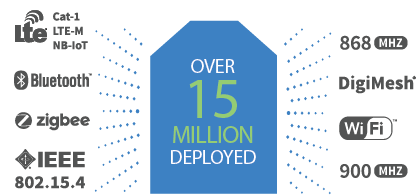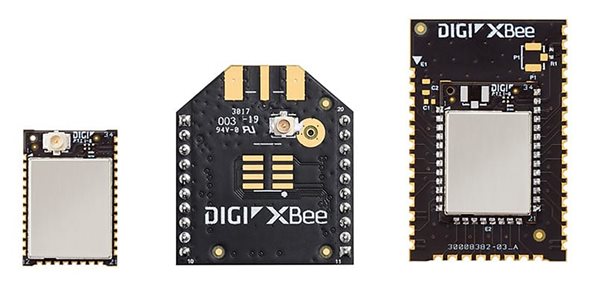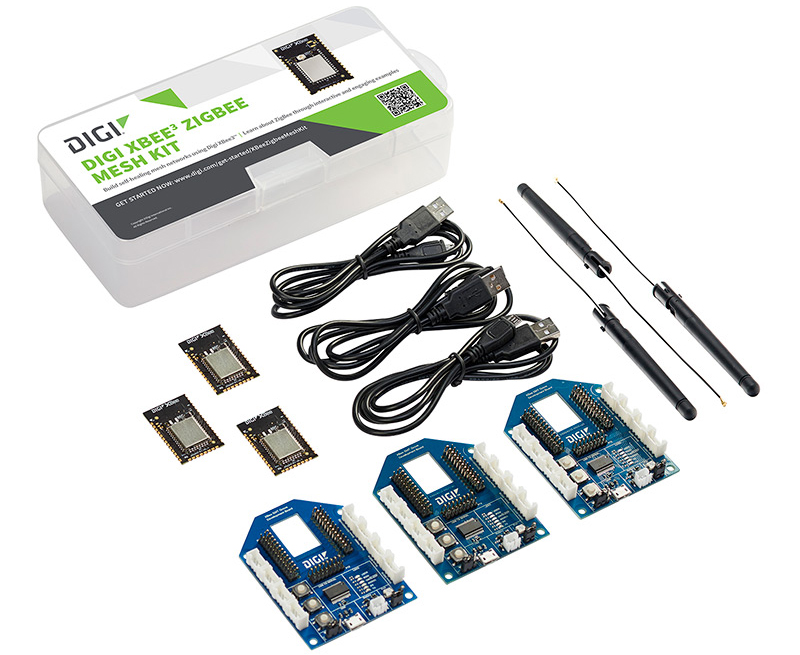Building a wireless, connected product with a range of connectivity features? The decision to go forward with prototyping and design is the easy part. Then you have choices to make. What communications protocol will work best for your use case? How will devices talk to one another? And what features — such as Bluetooth connectivity — will make your product market ready? In this blog post, we cover the excellent features of
Digi XBee® 3 RF modules, and how the built options provide an excellent, flexible platform for a range of product designs.
Digi XBee 3 RF modules provide reliable wireless connectivity, getting you quickly to market with a compact, low-power, low-profile footprint. They offer multiple protocols using the same hardware, come pre-certified, and include I/O, python programmability, and the multi-layered protection of the
Digi TrustFence® security solution. Let's explore!
Three + 1 Protocols

Every Digi XBee 3 RF module is multi-lingual. Each can speak the language of four different wireless protocols. Whatever the job, Digi XBee 3 RF modules can implement the best solution for the task at hand. Let's cover the protocol options.
1. 802.15.4
Need to send data point-to-point with the lowest latency and greatest bandwidth? A Digi XBee 3 running 802.15.4 is the perfect choice. With full security, addressing and minimal overhead, you’ll have your wireless network running quickly, speeding your time to market while delivering reliable and cost-effective results.
2. Zigbee
Lots of devices located together perhaps from multiple manufacturers? Zigbee® mesh protocol is a popular, multi-vendor solution that allows radios to pass along messages through their neighbors, greatly extending the size and reliability of the network. Zigbee networks are self-forming and self-healing, combining plugged-in router nodes with battery-powered edge devices to create reliable systems.
3. DigiMesh
When you require a mesh network, but need to get beyond some of Zigbee’s limitations, DigiMesh is an excellent choice. There are no special node roles to be configured in advance and every radio can be running on a battery, all waking up to communicate at the same time. Larger data frames, better encryption, and simpler addressing are the payoff for choosing this manufacturer-specific protocol.
4. Bluetooth
Alongside any of the above protocols, Digi XBee 3 RF modules can also implement Bluetooth Low Energy (BLE) for secure remote configuration, communicating with external sensors or creating beaconing systems. Since BLE runs at 2.4 GHz it shares an antenna with the other protocols, further lowering costs.
Three Packages

Digi XBee 3 RF modules offer a choice of three standard form factors to help support a full range of connected product requirements.
1. Micro
The smallest and lightest Digi XBee 3 package supports mobility and occupies the least amount of PCB real estate. It is also the lowest-cost option. The micro form factor meets the needs of wearables, industrial robots, or aerospace. (NASA has sent Digi XBees into orbit!) At 13 mm x 19 mm this tiny surface-mount package is available with three antenna options for maximum flexibility.
2. Surface-mount SMT
This backwards-compatible footprint highlights Digi’s commitment to long-term product stability. Customers who integrated an XBee SMT footprint in the past can simply continue using the newer Digi XBee 3 modules without any changes to their circuit boards or enclosures. It also has room for a few additional pinouts, adding flexibility.
3. Through-hole THT
The original Digi XBee footprint is still very popular. Many custom and third-party products continue to support this classic design, often with sockets that allow swapping radio modules with zero rework. Digi’s continued support for this legacy footprint allows customers to upgrade modules quickly without any design changes, saving money, time and eliminating hassle.
Ten Features to Support a Vast Range of Applications

Digi XBee 3 RF is more than a wireless module. It’s a powerful platform for IoT solutions, supported by a full range of developer solutions — Digi XBee Tools.
Together the Digi XBee ecosystem of tools, modules and supporting resources supports your wireless product developement and connectivity goals — whether your're building a smart city application, a robotics device, an industrial edge solution or the next breakthrough product in green tech and sustainability.
Here are some of the top features of Digi XBee 3 RF modules:
1. Edge Intelligence
Digi XBee 3’s built-in edge processing eliminates the time, expense and complications of adding a separate microcontroller. With MicroPython, an easy-to-learn scripting and programming language, you can rapidly prototype intelligent behaviors and execute required business rules. Cryptic sensor readings can be transformed into useful data, excess transmissions can be intelligently filtered out, and modern sensors and actuators can be employed directly, lowering complexity and costs.
2. Bluetooth
Every Digi XBee 3 is able to speak Bluetooth Low Energy as a second language. In addition to the configuration, beaconing and sensor capabilities mentioned above, Digi also provides a complete SDK for creating mobile applications that connect with Digi XBee 3 over BLE.
3. Low-power Operation
Every Digi XBee 3 is designed to minimize power use and extend battery life during normal operations. Modules can also be put into an ultra-low-power “sleep” modes either on a timer, triggered by signals from an external device, or with onboard programs that wake the module only when needed.
4. Pre-certification
Digi XBee modules are pre-certified for use in multiple regions, reducing development costs and time to market. In some cases the only end-user requirement is proper labeling. In other contexts, regulators might request additional testing but because the underlying module is already approved, passing those is greatly simplified.
5. Connection Reliability
Standards-based 802.15.4 protocol includes checksums, acknowledgements and configurable retries, to help ensure messages reach their destination. Mesh protocols such as DigiMesh or Zigbee offer reliable ad-hoc network creation in a self-healing mesh, so that if devices are damaged or removed, the network automatically reconfigures itself for continued operation.
6. TrustFence Security
This suite of security features provides authentication, encryption, privacy and system protection onboard every Digi XBee 3. Secure boot, secure connections, secured storage, and protected ports defend your devices and their data from unwanted intrusions, helping to keep you secure from digital interlopers.
7. Over-the-air (OTA) Updates
Every Digi XBee 3 can be updated remotely and securely from the cloud. There’s no need for physical access to change module configurations, update firmware, or load new edge application code. Digi Remote Manager can accomplish all of this via an authenticated connection from anywhere in the world, with automated scripting for managing large numbers of devices.
8. Multi-programmer
Update and configure Digi XBees in bulk using this combination of hardware and software that prepares devices for distribution and large network deployments. Each multi-programmer handles six modules, and multiple programmers can run simultaneously to maximize production speed. All Digi XBee 3 package types are supported natively.
9. Digi XCTU Configuration and Testing Tool
Digi XCTU® is a free, multi-platform application for configuration, testing, consoles, and networks maps that supports use on Windows, MacOS or Linux. It can be used to manage and control multiple RF devices, map networks, perform range tests, update firmware, display interactive consoles, perform spectrum analysis, manage API frames, plus many other options.
10. Remote Management
Digi Remote Manager is an online platform that allows users to easily activate, monitor and diagnose thousands of mission-critical devices all in one place. Edit configurations, update firmware, schedule and automate tasks from your desktop, tablet or even your phone. Multi-layered security safeguards everything and a rich scripting environment allows efficient automation of the tasks essential to managing large networks.
Summary and Next Steps

These four protocols, three packages and ten features highlight how flexible and cost-effective Digi XBee 3 RF Modules are for modern IoT systems. With Digi XBee 3, you will develop robust, high-performance connected products faster and more effectively, getting your product to market in the least amount of time.
A great way to get started is to explore our IoT development kits, which provide everything you need to develop and prototype your proof-of-concept, test connectivity and range, and prepare for manufacturing.
What are you building, and how can we help? Digi experts can support your quest for the right solution for your development needs, or provide the Wireless Design Services to help you get your product to market. Contact us to start the conversation.